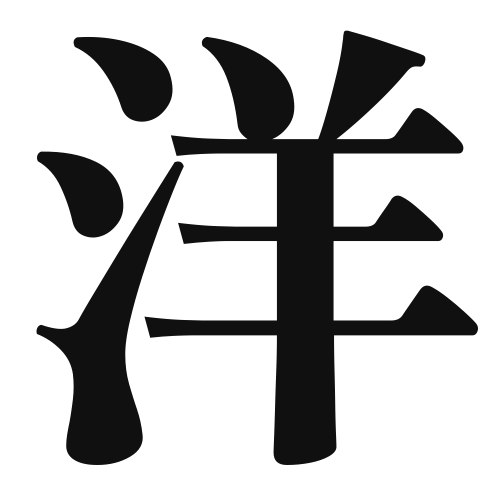1. Overview of Meaning
The kanji “洋” (yō) primarily means “ocean” or “Western.” It is often associated with things that are foreign or Western in nature, especially in contrast to traditional Japanese culture.
2. Formation and Radical
Formation of the Kanji: The kanji “洋” is a phonetic-ideographic character (形声文字). It combines the radical for “water” (氵) on the left, which relates to the ocean, and the phonetic component “洋” on the right, which suggests its pronunciation.
Radical: The radical of “洋” is 氵, which is related to water, emphasizing its connection to the ocean.
3. Examples of Usage
Common Words and Phrases: Some frequently used words that include “洋” are:
- 洋服 (yōfuku) – Western-style clothing
- 洋画 (yōga) – Western-style painting
- 洋食 (yōshoku) – Western cuisine
Example Sentences in Daily Conversation:
- 彼は洋服が好きです。 (Kare wa yōfuku ga suki desu.) – He likes Western-style clothing.
- 今夜は洋食を食べに行きましょう。 (Kon’ya wa yōshoku o tabe ni ikimashou.) – Let’s go eat Western cuisine tonight.
4. Synonyms and Antonyms
Similar Kanji: A similar kanji is “海” (umi), which means “sea” or “ocean.” While both relate to water, “洋” specifically refers to the ocean or Western aspects, whereas “海” is more general.
Opposite Kanji: An antonym is “和” (wa), which means “harmony” or “Japanese.” It represents traditional Japanese culture, contrasting with the Western connotation of “洋.”
5. Cultural and Historical Background
Relation to Japanese Culture: The kanji “洋” reflects Japan’s historical interactions with Western countries, especially during the Meiji Restoration when Japan began to adopt Western technologies and customs.
Proverbs and Idioms: One common phrase is “洋の東西” (yō no tōzai), which means “the East and West,” highlighting the cultural exchange between Japan and Western nations.
